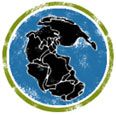
We recommend you visit the interactive version, where you can vote for your
favorite suspect. The text to the right is provided for printing purposes.
|
What
caused the greatest mass extinction in the history of life on Earth?
Half-a-dozen plausible theories have made headlines since the early 1970s, and
Doug Erwin, a paleontologist at the Smithsonian Institution, has investigated
all of them. But this "cacophony of causes," as Erwin calls it, doesn't mean
scientists are wishy-washy. It's just a reflection of how tough it is to tease
out what happened at the end of the Permian Period, roughly 250 million years
ago, and how creative theorists can be. Below, get a quick primer on the
suspects, as well as Doug Erwin's expert take.—Susan K. Lewis

|
|
Asteroid or Comet Impact
Most experts agree that a massive object from outer space struck Earth near the
Yucatan Peninsula at the close of the Cretaceous, ending the reign of the
dinosaurs. Did an asteroid or icy comet also cause the Permian extinction 185
million years earlier? Here's the doomsday scenario: An impact triggers
earthquakes, tsunamis, and a shockwave of heat, incinerating the surrounding
landscape. Hot debris from the impact rains down over a wide region, igniting
wildfires that burn for weeks on end. More importantly, the airborne dust and
gases from the impact and the fires filter out sunlight for months, shutting
down photosynthesis and dramatically cooling the Earth. The cold period is
followed by extreme heat, as the skies clear of dust particles yet remain full
of greenhouse gases. The extreme climatic shifts devastate life around the
globe.
|

|
|
Volcanism
At the end of the Permian, over about one million years, a series of eruptions
inundated an area the size of the continental U.S. with layer upon layer of
lava and ash, leaving deposits up to four miles thick across what is today
Siberia. In total, nearly a million cubic miles of magma was unleashed. In
addition to the Permian wipeout, half-a-dozen extinction events in the past 250
million years are contemporaneous with similar but smaller-scale volcanism.
Coincidence? Here's how eruptions could kill life far and wide: First,
sulfurous gas and dust circle the Earth, blocking sunlight and creating storms
of acid rain. Then years of cold are followed by decades of unbearable warming,
as carbon dioxide and methane linger in the atmosphere.
|

|
|
Formation of Supercontinent
Earth's landmasses slowly move to shape new continents through time. Geologists
in the 1970s devised this extinction scenario: the formation of the
supercontinent Pangea (or "all Earth") decimates life in two ways. First, as
species on separate landmasses and in different waters come together, they
compete for resources, and the losing species die out. Second, Pangea's
creation affects regional and global climates. Once-warm waters become
intolerably cold. The vast interior of the continent experiences wild seasonal
swings (think Siberia but worse). In short, most species face new stresses, and
as some perish, the effect ripples through the web of life, killing many
others. Since the 1970s, though, evidence has mounted that Pangea formed in the
middle of the Permian, not at its end.
|

|
|
Glaciation
Global cooling and the spread of gargantuan glaciers likely caused the second
largest mass extinction in Earth's history, the Ordovician, which took place
439 million years ago. Was it behind the Permian wipeout as well? Here's the
picture: Growing glaciers pull water from the ocean and reduce the area of
shallow continental shelves, which are home to the greatest diversity of marine
plants and animals. Species compete fiercely for resources, and many lose out.
On land, with giant glaciers encroaching, species unable to migrate toward
proverbial greener pastures also perish. Geologists have found evidence in rock
deposits throughout Europe and Asia, however, that sea level at the end of the
Permian was rising, casting doubt on this theory.
|

|
|
Anoxic Oceans and Bacteria
The deep ocean as well as shallow marine habitats appear to have had low oxygen
levels at the end of the Permian. This condition, called anoxia, could have
been the linchpin in the extinction tale. For most marine life, the anoxia
would have meant suffocation. But other life—particularly anaerobic
bacteria that give off hydrogen sulfide—would have thrived. The hydrogen
sulfide would have spread through the oceans, killing more species, and as it
slowly fizzed out into the atmosphere, it would have poisoned life on land as
well. Hydrogen sulfide in the atmosphere then would have damaged the ozone
layer, opening paths for deadly ultraviolet radiation to reach the remaining
life on Earth.
|

|
|
Methane Gas
Today, sediments on continental shelves contain vast amounts of methane, just
as they did during the Permian. Some climate scientists fear that our
present-day warming oceans could eventually release this methane into the
atmosphere, with cataclysmic consequences. Methane, besides being toxic to most
organisms, is also a potent greenhouse gas. At the end of the Permian, a great
outpouring of methane could have caused runaway global warming and ended much
of life on the planet. Even if this scenario turns out to be false, it holds a
cautionary tale about how moderate global warming could suddenly turn
severe.
|

|
|
One Expert's View
Learn
why Doug Erwin thinks there are No Easy Answers.
|
|
|









